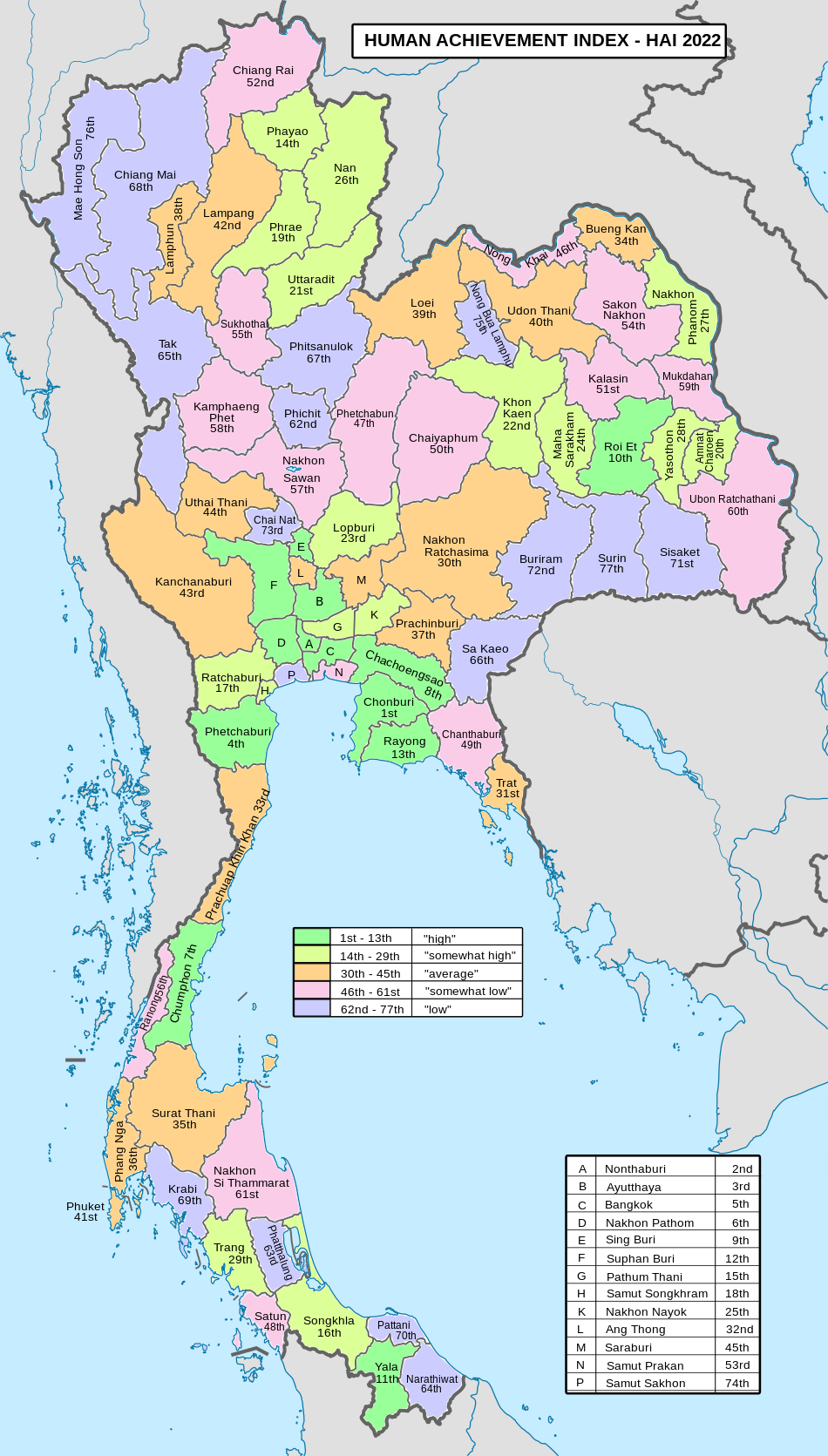Phayao Province
| Phayao province | |
|---|---|
 | |
| Thai name | |
| Thai | พะเยา |
| RTGS | Phayao |
| Northern Thai name | |
| Northern Thai | ᩕᨻᨿᩣ᩠ᩅ (Phayuao) |
Geography
The Phi Pan Nam Range runs across the province from north to south. The city of Phayao is on Phayao Lake (Kwan Phayao) in the valley of the Ing River. Three big mountains surround the valley, the Doi Luang (1,694 m), Doi Khun Mae Fat (1,550 m) and Doi Khun Mae Tam (1,330 m). The total forest area is 3,182 km (1,229 sq mi) or 51.4 percent of provincial area.
National parks
There are a total of five national parks, four of which are in region 15 (Chiang Rai) and Tham Sakoen in region 13 (Phrae) of Thailand's protected areas.
- Doi Luang National Park, 1,169 km (451 sq mi)
- Doi Phu Nang National Park, 860 km (330 sq mi)
- Mae Puem National Park, 351 km (136 sq mi)
- Phu Sang National Park, 285 km (110 sq mi)
- Tham Sakoen National Park, 250 km (97 sq mi)
Wildlife sanctuaries
There are two wildlife sanctuaries in region 15 (Chiang Rai) of Thailand's protected areas.
- Doi Pha Chang Wildlife Sanctuary, 571 km (220 sq mi)
- Wiang Lo Wildlife Sanctuary, 371 km (143 sq mi)
History
Phayao was founded in 1096 as a small city-state kingdom. In the 13th century it gained enough importance to be an equal partner with King Mangrai of Lan Na and the Sukhothai kingdom. However, a later king of Lanna and Nan captured Phayao in 1338, and made it part of Lanna. During the Burmese rule of Lanna, the city was deserted.
In 1843 in the reign of King Rama III, Phayao was re-established along with Chiang Rai and Muang Ngao to be a frontier city against the Burmese army located at Chiang Saen. In 1897 it became part of the province of Chiang Rai. On 28 August 1977, Phayao was separated from Chiang Rai and became a province of its own.
Symbols
The provincial seal shows Buddha, representing the famous Buddha image in the temple Wat Si Khom Kham called Phra Chao Ton Luang. Behind him are seven flames showing the glory of Buddha. In front of Buddha is a bowl and two ears of rice.
The provincial tree is Mammea siamensis. The Mekong giant catfish (Pangasianodon gigas) is the provincial aquatic life.
Administration

Provincial government
The province is subdivided into nine districts (amphoe). These are further divided into 68 subdistricts (tambon) and 632 villages (muban).
Local government
As of 26 November 2019 there are: one Phayao Provincial Administration Organisation (ongkan borihan suan changwat) and 35 municipal (thesaban) areas in the province. Phayao and Dok Khamtai have town (thesaban mueang) status. Further 33 subdistrict municipalities (thesaban tambon). The non-municipal areas are administered by 36 Subdistrict Administrative Organisations - SAO (ongkan borihan suan tambon).
Tourism



Sights
An extensive fresh-water lake, Kwan Phayao (กว๊านพะเยา) is the largest fresh-water fish habitat in the upper north which provides the livelihood of many of the local people. To protect the lake from pollution, motor boats are not allowed on the lake.
The Pho Khun Ngam Mueang Memorial (อนุสาวรีย์พ่อขุนงำเมือง) commemorates a former king of Phayao, or Phu Kam Yao, who was in power some 700 years ago. During his reign, the state prospered and expanded its territory.
Wat Si Khom Kham (วัดศรีโคมคำ) It houses the largest Buddha statue of Lanna Thai, Phra Chao Ton Luang, a sitting Buddha with a lap width of 16 meters and height of 18 meters. It is said that it took no fewer than 33 years to complete.
Ho Watanatham Nithat (หอวัฒนธรรมนิทัศน์). The indigenous museum deals with the history and ancient relics of Phayao, including native culture and traditions and creativity.
Wat Lee or Wiang Phayao Museum (พิพิธภัณฑ์เวียงพยาว (วัดลี)) Wat Lee is a Buddhist Temple which contains local history of Phayao. The museum contains more than 5000 pieces of historical object such as Sandstone Buddha Figure, 500 year-old Sandstone inscriptions, plam leaf menuscripts and the local pottery.
Kwan Phayao Pavilion and the Phayao Fresh-water Fishery Station (พระตำหนักกว๊านพะเยาและศูนย์วิจัยและพัฒนาประมงน้ำจืดพะเยา) is the first facility in the world to successfully breed pla buk, the Mekong giant catfish. There is an aquarium displaying many species of fish and water plants.
The Chiang Saen-style Chedi at Wat Si Umong Kham (วัดศรีอุโมงคำ) is still in good condition. The Lanna-style Buddha statue, Phra Chao Lan Tu (พระเจ้าล้านตื้อ), is regarded as the most beautiful anywhere.
Wat Phra That Chomthong (วัดพระธาตุจอมทอง) Surrounded by an arboretum, the temple offers a panoramic view of the town and the lake.
Wat Analyo (วัดอนาลโย) Covering an extensive area, cool and shady under leafy canopies of large trees it features buildings and sculptures of religion-based characters by contemporary craftsmen of great skill.
Namtok Champa Thong (น้ำตกจำปาทอง) is a beautiful and tall waterfall amid natural surroundings.
Ban Tham Indigenous Cultural Centre (ศูนย์วัฒนธรรมพื้นบ้านบ้านถ้ำ) It has a large collection of native agricultural tools and implements as well as ancient objects from which the cultural lifestyle of the Lanna people in the past can be studied.
Doi Phu Nang National Park (อุทยานแห่งชาติดอยภูนาง) A variety of birds are found, especially peacocks which come to the park area for breeding from January to March. The park also has a scenic waterfall called Namtok Than Sawan.
Chiang Kham (เชียงคำ) is home to many Thai Lue people. An interesting temple in Chiang Kham is Wat Nantaram (วัดนันตาราม), a Burmese-style site built entirely with teak. Another place of interest is Wat Phra That Sop Waen (วัดพระธาตุสบแวน) with its 700-year-old Lanna-style chedi.
Namtok Phu Sang (น้ำตกภูซาง) It is fed by a hot spring on the mountain which flows into the brook before cascading over the falls.
Phu Lang Ka Forest Park is in Chiang Kham District and Pong District. It is around 900–1,720 metres above sea level. The main attractions are: Doi Hua Ling, Doi Phu Lang Ka and Doi Phu Nom.
Local products
Products made from water hyacinths. Hand-made cotton (ผ้าฝ้ายทอมือ) is a handicraft of the Thai Lue people.
Culture
Religion
Festivals
Sacrificial Combined Force 2324 Monument Fair (งานฉลองอนุสรณ์ผู้เสียสละพลเรือน ตำรวจ ทหาร 2324) is held annually at the end of January until the beginning of February at the memorial near the Chiang Kham Airport, Tambon Chiang Ban, Amphoe Chiang Kham. It is a merit making ceremony dedicated to the civilians, policemen, and soldiers, who died in their fighting with communist insurgents in 1980-early 1981 (2523-early 2524 B.E.). It is a charity fair to raise money to assist the descendants of the deceased. Other activities include games, performances, exhibitions and various booths of the governmental authorities.
Winter and Red Cross Fair (งานฤดูหนาวและงานกาชาด) is held at the end of December until the beginning of January every year at the ground near the Phayao Bus Terminal. In the event, there is a fair full of booths from the governmental and private authorities, contests, as well as, various games.
Cassie Flower Blooming Day (งานวันดอกคำใต้บาน) takes place on 14 February every year at the ground in front of the Dok Khamtai District Office. Activities are the handicraft contests and sales of souvenirs.
Pho khun Ngam Mueang Fair (งานบวงสรวงพ่อขุนงำเมือง) on 5 March every year at the Pho khun Ngam Mueang Monument with a procession of the worship offerings.
Thai Lue Cultural Festival (งานสืบสานตำนานไทลื้อ) happens at the beginning of March every year at the Wat Phrathat Sop Waen, Amphoe Chiang Kham, consisting of folk games, cultural performances, as well as, lifestyle of the Thai Lue people. In the event, people will dress up in the traditional costume. Also, there will be a cotton spinning demonstration, dessert making, Lue singing, Choeng or martial art dance, and Makon game.
Songkran Festival (Pi Mai Mueang) (งานประเพณีสงกรานต์-ปี๋ใหม่เมือง) is held during 13–16 April every year behind the Mueang Phayao Municipality and in every district.
Pu Cha Phaya Lo Fair (Bucha Phra Lo) (ประเพณีปู่จาพญาลอ-บูชาพระลอ) is held on 9 April every year at Wiang Lo Ancient Town, Ban Huai Ngio, Amphoe Chun, with an aim to pay respect to the Wiang Lo ancestors and to create folk consciousness to cherish and preserve the site. In the event, there are parades, light and sound presentations, a procession inviting the spirits of Wiang Lo's past kings, khantok dinner at night, as well as cultural performances.
Phayao Lychee and Quality Products Fair (งานเทศกาลลิ้นจี่ และของดีเมืองพะเยา) takes place in May every year at the ground behind the Mueang Phayao Municipality. In the event, there are fairs offering lychees and quality products of Phayao and a lychee beauty pageant.
Sky Rocket Festival (งานทำบุญบั้งไฟ) is held in June every year at Tambon Ang Thong, Amphoe Chiang Kham. In the festival, there is a traditional dance procession and sky rocket contest.
Candle Procession Festival (งานแห่เทียนพรรษา) takes place one day before the Buddhist Lent Day at the ground behind the municipality office and in every district. Beautifully engraved candles are brought to participate in the parade. Various cultural shows are performed, as well as, the contest for the most beautiful candle is organized. After the contest, all the candles are offered to the temples.
Hilltribe Traditional Festival (งานประเพณีชาวเขา) is held in December every year at Tambon Rom Yen, Amphoe Chiang Kham. Traditional dances and games of the hill tribe people, which are a winter tradition, are performed.
Human achievement index 2022
Since 2003, United Nations Development Programme (UNDP) in Thailand has tracked progress on human development at sub-national level using the Human achievement index (HAI), a composite index covering all the eight key areas of human development. National Economic and Social Development Board (NESDB) has taken over this task since 2017.
| Rank | Classification |
| 1 - 13 | "high" |
| 14 - 29 | "somewhat high" |
| 30 - 45 | "average" |
| 46 - 61 | "somewhat low" |
| 62 - 77 | "low" |
| Map with provinces and HAI 2022 rankings |

|
Gallery
-
Phayao Lake
-
Tham Sa Koen National Park
-
Tham Sa Koen National Park
References
- ^ "ตารางที่ 2 พี้นที่ป่าไม้ แยกรายจังหวัด พ.ศ.2562" [Table 2 Forest area Separate province year 2019]. Royal Forest Department (in Thai). 2019. Retrieved 6 April 2021, information, Forest statistics Year 2019, Thailand boundary from Department of Provincial Administration in 2013
{{cite web}}: CS1 maint: postscript (link) - ^ รายงานสถิติจำนวนประชากรและบ้านประจำปี พ.ส.2562 [Statistics, population and house statistics for the year 2019]. Registration Office Department of the Interior, Ministry of the Interior. stat.bora.dopa.go.th (in Thai). 31 December 2019. Retrieved 26 February 2020.
- ^ "ข้อมูลสถิติดัชนีความก้าวหน้าของคน ปี 2565 (PDF)" [Human Achievement Index Databook year 2022 (PDF)]. Office of the National Economic and Social Development Council (NESDC) (in Thai). Retrieved 12 March 2024, page 47
{{cite web}}: CS1 maint: postscript (link) - ^ "Gross Regional and Provincial Product, 2019 Edition". <>. Office of the National Economic and Social Development Council (NESDC). July 2019. ISSN 1686-0799. Retrieved 22 January 2020.
- ^ Doi Luang, Phi Pan Nam Range – Climbing, Hiking & Mountaineering
- ^ "ข้อมูลพื้นที่อุทยานแห่งชาติ ที่ประกาศในราชกิจจานุบกษา 133 แห่ง" [National Park Area Information published in the 133 Government Gazettes]. Department of National Parks, Wildlife and Plant Conservation (in Thai). December 2020. Retrieved 1 November 2022.
- ^ "ตาราง 5 พื้นที่เขตรักษาพันธุ์สัตว์ป่า พ.ศ. 2562" [Table 5 Wildlife Sanctuary Areas in 2019] (PDF). Department of National Parks, Wildlife Sanctuaries and Plant Conservation (in Thai). 2019. Retrieved 1 November 2022.
- ^ "Number of local government organizations by province". dla.go.th. Department of Local Administration (DLA). 26 November 2019. Retrieved 10 December 2019.
40 Phayao: 1 PAO, 2 Town mun., 33 Subdistrict mun., 36 SAO.
- ^ "Kwan Phayao Lake". Tourism Authority of Thailand (TAT). Retrieved 18 May 2015.
- ^ Phu Langka Forest Park | Bangkok Post: Travel
- ^ "Population by religion, region and area, 2015" (PDF). NSO. Retrieved 2017-10-12.
External links
 Phayao travel guide from Wikivoyage
Phayao travel guide from Wikivoyage- Provincial Website
- Phayao provincial map, coat of arms and postal stamp Archived October 6, 2010, at the Wayback Machine






